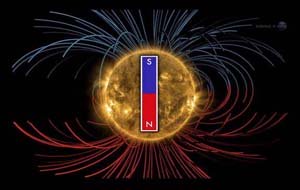Science Current Events
Sun’s Magnetic Poles
Science Current Events Introduction
In the next few months the
positive pole of the sun will suddenly change into a negative pole on the sun.
The switch in pole polarity occurs about once every eleven years. Scientists
have document the changing of the pole for a while and NASA has a graph showing
when it changed in previous years.
Reversal of magnetic fields
The reversal of the
magnetic field occurs on a regular basis during the peak of the sunspot cycle.
The changing of the magnetic poles here on Earth is important because of
today’s communication system that can sometimes be affected when the poles
suddenly flip.

Sun’s Magnetic Poles switch every 11 years, NASA
Peak of the sunspot cycle
The peak of the sunspot
cycle when the poles suddenly flip has an increased bursts of plasma that are
launched into space. This is the smallest sunspot cycle in at least 100 years.
The only worry is with space weather and how it might affect the power grid
here on Earth. Since it is the smallest sunspot cycle in over 100 years there
is not much expectation of a major problem here on Earth.
Ripple effect on the solar system
The change has ripple
effects throughout the solar system. The sun sends out currents from the sun
that form a kind of flat sheet extending billions of kilometers outward from
the sun’s equator. When the poles switch ends the sheet becomes wavy. The orbit
of Earth as it travels around the sun dips into and out of the current sheet of
energy. When the poles reverse the sheet dips creating storm space weather.
11-year solar cycle
The peak of the sun’s
11-year solar cycle is when the sun’s polar magnetic fields weaken and go to
zero. The fields emerge with the opposite polarity after this go to zero. The
changing of the poles can create stormy space weather that protects us from
dangerous cosmic rays coming in from outer space after a supernova explosion.
Protecting satellites and astronauts in space
The wrinkled effect of the sheet protects both satellites and astronauts in
space from the particles produced by supernova explosions coming into the solar
system.
More Science Current Events & News
Science Articles for Kids - Includes science current events about the Sun’s magnetic poles changing, tourist in space, a two-toned lobster, Kepler telescope discoveries and our science newsletter for kids.
Science Current Events – Sun’s Magnetic Poles The Sun’s magnetic poles switch polarity once every eleven years. This is due to occur in the next few months.
Current Events in Earth Science – Space Tourist Virgin Galactic’s Space Ship Two (SS2) flew over the Mojave Desert in California on September 5, 2013. Virgin Galactic’s goal is flying tourists into space by 2014.
Kids Current Events – Two-toned Lobster A rare two-toned lobster was caught off the coast of Maine. It is estimated that only 1 in 50 million lobsters will have this coloration.
Current Events in Science – Kepler’s Space Telescope NASA’s top planet hunting telescope was launched on March 6, 2009. The telescope has found thousands of planets outside our Solar System since it was launched.
Science Trivia Science page includes information about the discovery of Pluto, cave formation, Mammoth Cave, bones of the human skeleton, Genghis Khan, industrial revolution, spinning jenny and much more.
Science Inventions The first navigation system was developed for captains sailing in foggy conditions to keep ships from colliding in the fog. The US Military developed an improved system in 1939.
Kids Science Newsletter Our FREE science newsletter is published each month during the school year. The newsletter includes science news, trivia, and a fun activity. Check out a sample of our newsletter on this page.
KIDS FUN Science Bookstore
Check out Myrna Martin's award winning textbooks, e-books, videos and rock sets. The Kids Fun Science Bookstore covers a wide range of earth science topics. Click here to browse.










